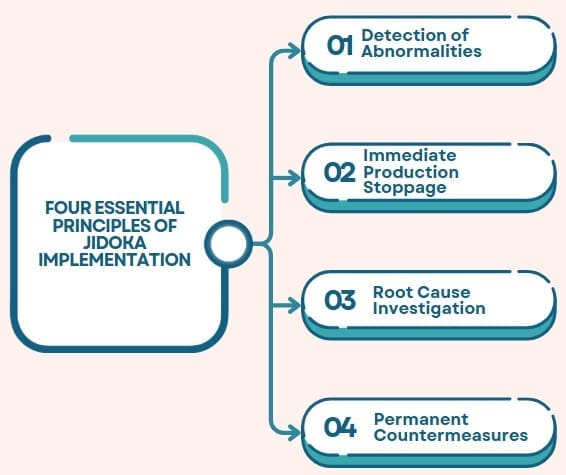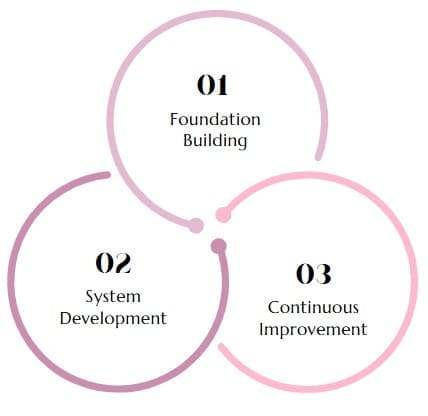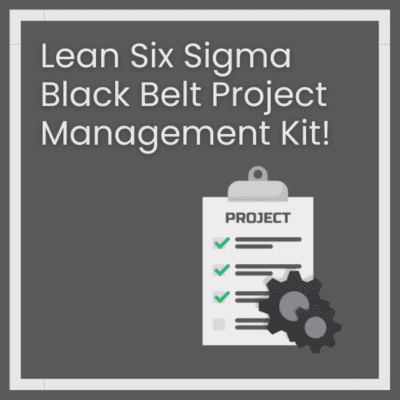Jidoka is a fundamental concept in Lean manufacturing and the Toyota Production System (TPS), often referred to as “automation with a human touch” or autonomation. At its core, Jidoka empowers machines and operators to halt production immediately upon detecting an abnormality, ensuring that defects are caught early and do not pass down the production line. This proactive approach not only maintains high product quality but also fosters a culture of continuous improvement.
Originally developed by Toyota, Jidoka represents far more than a simple quality control measure. Rather, it embodies a philosophy that empowers workers, prevents defects, and drives systematic improvement across entire production processes. This comprehensive approach has revolutionized how companies worldwide approach manufacturing excellence.
Table of contents
What is Jidoka?
Jidoka, often translated as “autonomation” or “automation with a human touch,” represents a fundamental principle within lean manufacturing systems. The term combines automation capabilities with human intelligence, creating a powerful framework for quality assurance and continuous improvement.
At its core, Jidoka means empowering machines and workers to detect problems immediately and stop production when defects occur. This proactive approach prevents defective products from advancing through the production line, ultimately saving time, resources, and maintaining quality standards.
The Jidoka definition encompasses several key elements:
- Immediate detection of abnormalities or defects
- Automatic stopping of production processes when issues arise
- Investigation and resolution of root causes
- Prevention of defect recurrence through systematic improvements
This methodology transforms traditional manufacturing approaches by shifting focus from reactive problem-solving to proactive quality prevention. Consequently, organizations implementing Jidoka principles experience significant improvements in product quality, operational efficiency, and customer satisfaction.
Public, Onsite, Virtual, and Online Six Sigma Certification Training!
- We are accredited by the IASSC.
- Live Public Training at 52 Sites.
- Live Virtual Training.
- Onsite Training (at your organization).
- Interactive Online (self-paced) training,
Jidoka in the Toyota Production System
The Toyota Production System (TPS) is renowned for its efficiency, quality, and continuous improvement. Jidoka is one of its two main pillars, alongside Just-in-Time (JIT).
How Jidoka Works in TPS?
- Machines are equipped with sensors to detect abnormalities (e.g., out-of-spec parts).
- If a problem is detected, the machine stops automatically, or the operator can pull a cord (Andon) to halt the line.
- The issue is immediately investigated and resolved before production resumes.
TPS Principles Related to Jidoka
- Built-in quality: Every process is responsible for its own quality.
- Immediate problem resolution: Issues are addressed at the source, not passed downstream.
- Continuous improvement (Kaizen): Each problem is an opportunity to improve the process.
Historical Origins of Jidoka in Toyota’s Manufacturing Evolution
Understanding Jidoka’s development requires examining Toyota’s historical journey toward manufacturing excellence. The concept originated from Sakichi Toyoda’s innovative approach to textile manufacturing in the early 1900s. Toyoda developed automatic looms that would stop immediately upon detecting broken threads, preventing defective fabric production.
Taiichi Ohno, widely recognized as the father of TPS, later adapted this principle for automotive manufacturing. Ohno understood that preventing defects at their source would prove more efficient than detecting and correcting them downstream. This insight became fundamental to the Toyota way of manufacturing.
The evolution of Jidoka within Toyota’s production system demonstrates how innovative thinking can transform entire industries. By empowering workers to stop production lines when problems arise, Toyota created a culture of quality ownership that extends throughout the organization.
Furthermore, this historical development showcases how traditional craftsmanship principles can enhance modern manufacturing systems. The combination of human expertise with automated systems creates robust quality assurance mechanisms that adapt to changing production requirements.
The Four Essential Principles of Jidoka Implementation

Successful Jidoka implementation relies on four interconnected principles that work together to create comprehensive quality assurance systems:
1. Detection of Abnormalities
The first principle focuses on identifying problems immediately when they occur. This involves training workers to recognize quality issues, installing sensors and monitoring systems, and establishing clear standards for acceptable product quality.
Effective detection systems combine human observation with technological monitoring. Workers develop keen awareness of normal production patterns, enabling them to identify deviations quickly. Meanwhile, automated systems provide continuous monitoring of critical process parameters.
2. Immediate Production Stoppage
Once abnormalities are detected, production must stop immediately to prevent defective products from advancing through the system. This principle requires courage from workers and full management support for stopping production when necessary.
The immediate stoppage principle distinguishes Jidoka from traditional quality control approaches. Rather than allowing defective products to continue through production for later correction, Jidoka prevents waste by addressing problems at their source.
3. Root Cause Investigation
Stopping production creates opportunities for thorough investigation of underlying causes. This principle emphasizes systematic problem-solving techniques that identify why problems occurred, not just what happened.
Root cause investigation involves multiple stakeholders, including operators, supervisors, and technical specialists. This collaborative approach ensures comprehensive understanding of problems and develops effective solutions that prevent recurrence.
4. Permanent Countermeasures
The final principle focuses on implementing lasting solutions that prevent similar problems from occurring again. This involves modifying processes, updating procedures, training workers, or installing new equipment as necessary.
Permanent countermeasures require ongoing monitoring and validation to ensure effectiveness. Organizations must verify that implemented solutions actually prevent problem recurrence while maintaining overall production efficiency.
Jidoka vs. Traditional Quality Control
Traditional quality control approaches typically rely on inspection and correction after production completion. This reactive methodology often results in waste, rework, and delayed problem resolution. In contrast, Jidoka lean principles emphasize prevention through real-time quality assurance.
The fundamental difference lies in timing and responsibility. Traditional systems assign quality control to specialized inspectors who examine finished products. Jidoka empowers every worker to act as a quality inspector, creating distributed responsibility for product excellence.
Moreover, traditional approaches often accept certain defect rates as inevitable. Jidoka challenges this assumption by striving for zero defects through systematic prevention. This philosophical shift transforms organizational culture and operational performance.
Economic implications also differ significantly between these approaches. While traditional quality control incurs costs through inspection, rework, and waste, Jidoka reduces these expenses by preventing defects initially. The long-term cost savings often exceed implementation investments.
Also Read: What is the Toyota Production System?
Jidoka vs. Just-in-Time
| Pillar | Focus | Key Benefit | Example in Toyota |
| Jidoka | Built-in quality, defect prevention | Quality assurance | Automatic line stops for defects |
| Just-in-Time (JIT) | Producing only what is needed, when needed | Efficiency, minimal waste | Kanban system for parts delivery |
Integration with Toyota Production System and Lean Manufacturing
Jidoka Toyota implementation works synergistically with other TPS principles to create comprehensive manufacturing excellence. The integration with Just-in-Time (JIT) Toyota systems creates powerful operational capabilities that minimize waste while maximizing quality.
Within the Toyota Production System, Jidoka serves as one of two main pillars, alongside JIT manufacturing. This dual foundation supports continuous improvement efforts while maintaining operational stability. The combination enables organizations to achieve both efficiency and quality objectives simultaneously.
Lean manufacturing Toyota principles benefit significantly from Jidoka implementation. By preventing defects at their source, Jidoka eliminates waste associated with rework, scrap, and customer complaints. This alignment supports broader lean transformation initiatives across organizations.
The integration also extends to Total Productive Maintenance (TPM) programs, where Jidoka principles help maintain equipment reliability and performance. Preventive maintenance strategies align with Jidoka’s emphasis on proactive problem prevention rather than reactive correction.
Real-World Applications and Industry Success Stories
Organizations across diverse industries have successfully implemented Jidoka principles to achieve remarkable improvements in quality and operational performance. These applications demonstrate the versatility and effectiveness of autonomation concepts beyond automotive manufacturing.
In electronics manufacturing, companies use Jidoka principles to detect component placement errors immediately during assembly processes. Automated systems monitor placement accuracy while workers verify proper component orientation, preventing defective products from advancing to subsequent operations.
Pharmaceutical manufacturers implement Jidoka through comprehensive monitoring systems that detect deviations in critical process parameters. These systems automatically stop production when measurements exceed acceptable ranges, ensuring product safety and regulatory compliance.
Food processing facilities utilize Jidoka principles to maintain hygiene standards and product quality. Workers monitor critical control points while automated systems track temperature, pressure, and other essential parameters throughout production processes.
Implementing Jidoka

Successful Jidoka implementation requires systematic planning and execution across multiple organizational levels. The following framework provides guidance for organizations beginning their autonomation journey:
Phase 1: Foundation Building
Begin by establishing management commitment and communicating the importance of quality excellence throughout the organization. Leadership must demonstrate unwavering support for stopping production when quality issues arise, even if this temporarily reduces output.
Train workers in problem identification techniques and provide them with authority to stop production when necessary. This empowerment represents a significant cultural shift that requires careful change management and ongoing reinforcement.
Phase 2: System Development
Identify critical quality parameters and establish monitoring systems that detect deviations immediately. This may involve installing sensors, implementing visual management systems, or developing inspection protocols.
Create standardized procedures for responding to quality issues, including escalation processes and problem-solving methodologies. Clear guidelines help workers respond consistently and effectively when problems occur.
Phase 3: Continuous Improvement
Establish regular review processes to analyze stopped production incidents and identify improvement opportunities. This ongoing analysis drives systematic enhancements to processes, equipment, and procedures.
Develop metrics to track Jidoka effectiveness, including defect rates, production stoppages, and improvement implementation. These measurements provide visibility into system performance and guide future enhancement efforts.
Also Read: Lean vs. Six Sigma: Choosing the Right Approach
Common Challenges and Solutions in Jidoka Implementation
Organizations implementing Jidoka often encounter predictable challenges that require proactive management and creative solutions. Understanding these obstacles helps organizations prepare effective mitigation strategies.
Cultural Resistance
Workers may initially resist stopping production due to concerns about productivity targets or management reactions. Overcoming this resistance requires consistent leadership support and positive reinforcement when workers identify problems.
Solution: Celebrate problem identification and resolution rather than penalizing production stoppages. Recognize workers who demonstrate courage in stopping production to address quality issues.
Initial Productivity Concerns
Short-term productivity may decrease as workers learn to identify problems and implement solutions. Management must maintain patience while systems mature and workers develop competence.
Solution: Focus on long-term benefits rather than immediate productivity metrics. Track quality improvements and cost savings to demonstrate Jidoka’s value over time.
Resource Requirements
Implementing Jidoka requires investments in training, monitoring systems, and problem-solving resources. Organizations must allocate sufficient resources to support successful implementation.
Solution: Develop phased implementation plans that spread costs over time while demonstrating early wins to justify continued investment.
The Future of Jidoka
Modern manufacturing environments are incorporating digital technologies that enhance traditional Jidoka principles. Industry 4.0 capabilities create new opportunities for real-time monitoring, predictive analytics, and automated problem detection.
Artificial intelligence and machine learning systems can identify subtle patterns that human operators might miss, extending Jidoka’s effectiveness beyond current capabilities. These technologies enable predictive quality assurance that prevents problems before they occur.
Internet of Things (IoT) sensors provide comprehensive monitoring of production processes, equipment performance, and environmental conditions. This expanded visibility supports more sophisticated Jidoka implementations that address complex quality challenges.
Digital twin technologies enable virtual testing of process changes before implementation, reducing risks associated with continuous improvement initiatives. This capability accelerates improvement cycles while maintaining production stability.
Key Performance Indicators and Metrics for Jidoka Success
Measuring Jidoka effectiveness requires comprehensive metrics that capture both quality improvements and operational impacts. Organizations should track multiple indicators to understand system performance comprehensively.
Quality metrics include defect rates, customer complaints, and warranty claims. These indicators demonstrate Jidoka’s impact on product quality and customer satisfaction over time.
Operational metrics encompass production stoppages, problem resolution times, and improvement implementation rates. These measurements provide insights into system efficiency and continuous improvement effectiveness.
Financial metrics track cost savings from reduced waste, rework, and customer returns. These indicators demonstrate Jidoka’s economic value and justify continued investment in quality improvement initiatives.
Final Words
Jidoka remains a cornerstone of the Toyota Production System and Lean manufacturing worldwide. By focusing on automation with a human touch, companies can ensure quality, reduce waste, and empower their teams to drive continuous improvement. Whether you’re in manufacturing, healthcare, or services, integrating Jidoka can transform your business processes and deliver lasting competitive advantage.
Frequently Asked Questions on Jidoka
What does Jidoka mean in manufacturing?
Jidoka means “autonomation” or “automation with a human touch,” representing a principle that empowers workers and machines to detect problems immediately and stop production when defects occur to prevent quality issues from advancing through the production system.
How is Jidoka different from traditional automation?
Traditional automation focuses on replacing human labor with machines, while Jidoka combines automation with human intelligence to create systems that can detect abnormalities and stop production automatically when problems arise, ensuring quality at every step.
What are the four principles of Jidoka?
The four principles of Jidoka are:
1) Detection of abnormalities,
2) Immediate production stoppage,
3) Root cause investigation, and
4) Implementation of permanent countermeasures to prevent recurrence.
Who developed the Jidoka concept?
Jidoka was originally developed by Sakichi Toyoda in textile manufacturing and later adapted for automotive production by Taiichi Ohno, who integrated it into the Toyota Production System as one of its fundamental pillars.
How does Jidoka support lean manufacturing?
Jidoka supports lean manufacturing by eliminating waste associated with defects, rework, and customer complaints. It prevents defective products from advancing through production, reducing overall waste and improving operational efficiency.
What industries can benefit from Jidoka implementation?
Jidoka principles can benefit any industry with production processes, including automotive, electronics, pharmaceuticals, food processing, aerospace, and consumer goods manufacturing.
How long does it take to implement Jidoka successfully?
Jidoka implementation typically takes 6-18 months depending on organizational size, complexity, and existing quality systems. Success requires systematic planning, worker training, and management commitment throughout the implementation process.
What are the main challenges in implementing Jidoka?
Common challenges include cultural resistance to stopping production, initial productivity concerns, resource requirements for training and systems, and the need for sustained management commitment to quality over short-term productivity metrics.



















